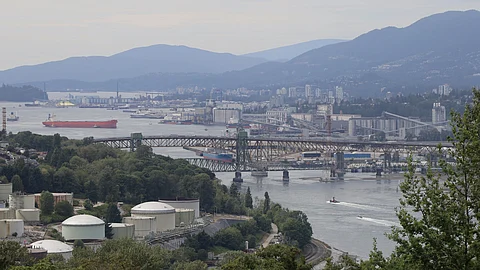

Getting to and from the North Shore means choosing between two bridges or the SeaBus — options that haven't changed in nearly 50 years despite a doubling of the region's population.
Frustrated by gridlock both on the roads and in government, North Vancouver resident Cheryl Atchison has taken it upon herself to try and get things moving via a petition demanding a re-evaluation of the region's transportation infrastructure.
"The North Shore is undergoing significant growth with new housing developments being proposed and approved," Atchison wrote. "However, our current roadway infrastructures fail to accommodate the increasing traffic volumes."
She lamented that "it often takes just a single accident or minor disruption to halt traffic to a standstill," and warned that "this gridlock is not merely an inconvenience; it's a potential hazard, particularly in emergencies."
In an interview with the West Coast Standard, Atchison explained that she first heard of the need for a third crossing long before moving to the North Shore 23 years ago. Since then, little concrete action has been taken to more efficiently move people from one side of Burrard Inlet to the other.
"There's at least 4,500 people that have signed the petition that are like minded with me that we want to see some some action, even if that's plans that are being solidified for the future," she said.
Less than 24 hours later, that number had risen to over 5,000.
"You need to get vocal," Atchison added, urging people to contact elected officials in their area. "We have three levels of government that are involved in these decisions, so we need all of them to come to the table and put a plan together that actually works to move people safely around the North Shore and over to Vancouver, up to Squamish and Whistler, and over to the ferries."
Among the politicians who shared her concerns was West Vancouver Mayor Mark Sager.
"We need some solutions and people are going to have to start thinking out of the box," he told the West Coast Standard. "If you live anywhere on the North Shore and you try and go from west to east, try and go over the Second Narrows Bridge anytime after 2:30 - 3:00, it's just hurry up and wait."
To deal with the east-west portion of the gridlock, he proposed taking advantage of the railway tracks that run parallel to the inlet.
"The CN rail is grossly under-utilized and that's a natural way to move people from Ambleside to at least Lonsdale Quay so they can get on the SeaBus," Sager said, suggesting that the company's recent decision to cease operations north of Squamish could be a sign that opportunities for communities further south may be just around the corner.
He added that a bike lane running the length of the tracks would encourage "active transportation."
Most of the congestion, however, occurs on the north-south routes.
The Lions Gate Bridge, built in 1938, was the first structure to span the two coasts, with the Ironworkers Memorial Bridge opening 22 years later six kilometres to the east. Officials eventually discovered that this wasn't enough to handle all the traffic, and weighed the options for an alternative. They opted for a ferry over a tunnel, and the SeaBus made its inaugural voyage between Vancouver and Lonsdale Quay in 1977.
Since then, efforts to move more people across the inlet have largely been via bus routes over the aforementioned bridges. In 2027, TransLink is scheduled to extend the R2 RapidBus from Park Royal to Phibbs Exchange over the Ironworkers all the way down to Metrotown.
Sager said he hoped this would help, but Atchison was less optimistic, arguing that buses will just end up "sitting in the same traffic we're sitting in."
She said a tunnel would be her preference, but made it clear that anything — be it a new bridge, improvements to existing spans, or a ferry service — would be welcome.
The idea of expanding Vancouver's ferry network was supported by Indian Arm Recreational Services Senior Captain Mike Bothma, who traverses the North Shore by motorcycle to get to and from work in Port Moody every day.
"Congestion is noticeable and getting tighter," he told the West Coast Standard, "so I believe an alternative is to use the water we have available and get people across the shore and connected with the SkyTrain or other potential use here on this side."
Both Bothma and Atchison made it clear that they doesn't expect a fix overnight, with the latter adding, "we just want to know that we're being heard."
In a statement, the BC Conservatives told the West Coast Standard their caucus stands with Atchison and her fellow petitioners, and will press Premier David Eby and the BC NDP to take action.
